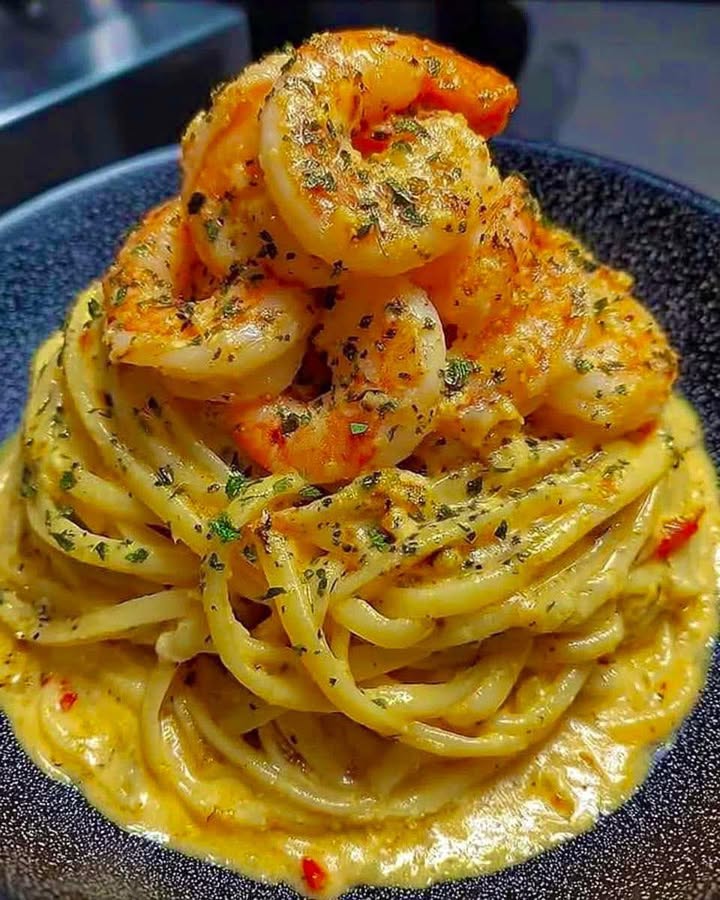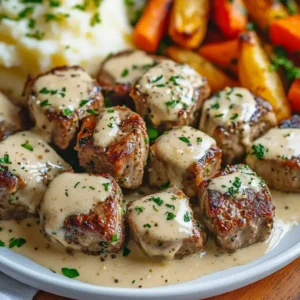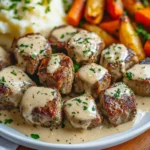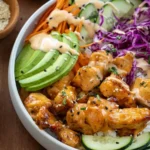Best Creamy Cheddar Linguine with Shrimp Recipe: A Decadent Seafood Pasta Dish
This Best Creamy Cheddar Linguine with Shrimp Recipe delivers restaurant-quality flavors in under 35 minutes. The combination of tender shrimp and sharp cheddar creates a rich, satisfying pasta dish that will become a family favorite. Moreover, the creamy sauce clings perfectly to every strand of linguine for maximum flavor in every bite.
When you crave comfort food with a seafood twist, this shrimp linguine recipe hits all the right notes. The sharp cheddar adds depth while the shrimp provides a delicate sweetness. Additionally, the dish comes together quickly, making it ideal for weeknight dinners or casual entertaining. You will love how the garlic and herbs enhance the natural flavors of both the shrimp and cheese.
Quick Recipe Highlights
- Flavor Profile: The sharp cheddar delivers a bold, tangy base while the shrimp adds subtle sweetness. Garlic and herbs round out the flavors with aromatic depth.
- Texture: Al dente linguine provides the perfect base for the creamy sauce. Meanwhile, the shrimp remain tender yet firm for satisfying contrast.
- Aroma: Fresh garlic and herbs create an inviting fragrance that builds anticipation. The cheese sauce develops a rich, comforting smell as it simmers.
- Visual Appeal: The golden cheese sauce coats each strand of pasta beautifully. Pink shrimp and green herbs provide striking color contrast.
- Skill Level Needed: Basic cooking techniques make this recipe accessible. However, timing the shrimp and sauce requires some attention.
- Special Equipment: A large pot for boiling pasta and a skillet for the sauce are essential. A whisk helps create a smooth cheese sauce.
Recipe Overview
- Difficulty Level: This recipe falls into the easy category because it uses straightforward techniques. While multitasking helps, each step remains simple to execute.
- Category: Perfect as a main course for seafood lovers. The dish also works well for pasta nights or casual dinner parties.
- Cuisine: While not strictly traditional, the recipe draws inspiration from Italian-American seafood pasta dishes. The cheddar twist gives it a unique character.
- Cost: Mid-range ingredients make this an affordable luxury. Fresh shrimp represent the biggest expense, while pantry staples round out the dish.
- Season: Excellent year-round, but particularly satisfying in cooler months. The rich sauce provides comfort during fall and winter.
- Occasion: Ideal for date nights, family dinners, or potluck contributions. The dish presents beautifully while remaining approachable.
Why You’ll Love This Recipe
The Best Creamy Cheddar Linguine with Shrimp Recipe satisfies cravings for both seafood and comfort food. First, the combination of textures creates an exciting eating experience. The linguine offers chewiness while the shrimp provide delicate bites. Then, the sauce brings everything together with its velvety consistency.
Convenience makes this recipe a weeknight hero. You can prepare the entire meal in one pot and a skillet. Furthermore, the ingredients are easy to find at any supermarket. The recipe also allows for flexibility with shrimp size and cheese sharpness.
Nutritionally, this dish provides balanced macros. The shrimp contribute lean protein while the pasta offers energizing carbohydrates. Using real cheese instead of processed sauces ensures better quality fats. You can also boost vegetables by adding spinach or peas.
For entertaining, this shrimp linguine impresses without stress. The dish looks elegant yet requires minimal last-minute attention. Guests will appreciate the homemade quality and rich flavors. You can easily double the recipe for larger groups.
Cost-effectiveness comes from using affordable ingredients creatively. While shrimp seem luxurious, you need only a moderate amount for flavor impact. The cheese sauce stretches beautifully to coat all the pasta. Leftovers also reheat well for next-day lunches.
Historical Background and Cultural Significance
Seafood pasta dishes have deep roots in Italian coastal cuisine. Traditionally, fishermen would prepare simple meals with their daily catch. Linguine alle vongole (with clams) remains a classic example of this tradition. However, the addition of cheddar represents a modern American twist.
Cheese with seafood was historically uncommon in Italian cooking. Many purists still avoid combining the two. Nevertheless, American cooks have embraced these flavor combinations. The sharpness of cheddar particularly complements sweet shellfish like shrimp.
Over time, shrimp pasta recipes evolved to include various sauces. Cream-based versions gained popularity in the mid-20th century. Restaurants often featured them as indulgent specials. Today, home cooks appreciate how quickly these dishes come together.
Regional variations continue to emerge across the United States. Some versions use local cheeses or add regional spices. The basic formula remains adaptable to different tastes and ingredient availability. This flexibility ensures the dish’s enduring appeal.
Ingredient Deep Dive
Linguine provides the ideal pasta shape for this recipe. The flat, narrow strands hold sauce beautifully without becoming gummy. When selecting linguine, look for Italian brands with rough surfaces. These textures help the sauce adhere better. Store dried pasta in a cool, dry place for up to two years.
Fresh shrimp make all the difference in flavor and texture. Look for firm, translucent shrimp with minimal odor. Medium or large sizes work best for this recipe. You can use fresh or frozen shrimp, but thaw frozen shrimp properly first. Pat them dry before cooking to ensure proper searing.
Sharp cheddar creates the signature sauce flavor. The aging process develops complex flavors that stand up to the shrimp. Avoid pre-shredded cheese, which contains anti-caking agents. These additives can make the sauce grainy. Instead, buy a block and grate it yourself for smoothest results.
Common Mistakes to Avoid
- Overcooking the shrimp makes them rubbery. Cook just until they turn pink and opaque, about 2-3 minutes per side.
- Using pre-shredded cheese often leads to clumpy sauce. The cellulose coating prevents smooth melting.
- Neglecting to salt the pasta water sufficiently results in bland linguine. The water should taste like the sea.
- Adding cheese to sauce that’s too hot can cause separation. Let the sauce cool slightly before incorporating cheese.
- Overcrowding the pan when cooking shrimp leads to steaming instead of searing. Work in batches if necessary.
- Skipping the pasta water reserve means missing a valuable sauce thickener. Save at least a cup before draining.
Essential Techniques
Properly cooking shrimp requires attention to visual cues. First, pat them dry to ensure good browning. Then, cook over medium-high heat just until they curl and turn pink. Overcooking makes shrimp tough, so err on the side of underdone. They will continue cooking slightly in the sauce.
Creating a smooth cheese sauce demands patience. Start with a roux of butter and flour for stability. Then, gradually add milk while whisking constantly. Remove the sauce from heat before adding cheese to prevent separation. Finally, thin with reserved pasta water as needed for perfect consistency.
Pro Tips for Perfect Creamy Cheddar Linguine with Shrimp
- Time your pasta to finish cooking just before the sauce is ready. This prevents the linguine from sticking together.
- Reserve more pasta water than you think you’ll need. You can always discard extra, but running out limits sauce adjustment.
- Grate your cheese while the sauce simmers. Freshly grated cheese melts more evenly than pre-shredded varieties.
- Consider adding a splash of white wine to the sauce for complexity. The alcohol cooks off, leaving behind bright flavor notes.
Variations and Adaptations
For regional twists, try substituting local cheeses. Pepper jack adds spice while smoked gouda contributes depth. You can also mix cheeses for layered flavor. Just maintain the total quantity to prevent sauce overload.
Seasonal adaptations might include summer vegetables like zucchini. In colder months, mushrooms add earthiness. Frozen peas work year-round for color and sweetness. Adjust cooking times based on vegetable tenderness.
Dietary modifications are straightforward for this recipe. Gluten-free linguine works perfectly in place of traditional pasta. For dairy-free versions, use nutritional yeast and coconut milk. The sauce will differ but still satisfy.
Serving and Presentation Guide
Plate the linguine with shrimp arranged attractively on top. Twirl the pasta neatly using tongs for restaurant-style presentation. Garnish with fresh parsley or chives for color contrast. Serve immediately while the sauce remains creamy.
Traditional accompaniments include crusty bread for sauce mopping. A simple green salad balances the richness. For wine pairings, choose crisp whites like Pinot Grigio. These cut through the cheese sauce beautifully.
Wine and Beverage Pairing
White wines with good acidity complement this dish perfectly. Sauvignon Blanc’s citrus notes brighten the rich sauce. Alternatively, Chardonnay offers buttery harmony. For non-alcoholic options, try sparkling water with lemon.
Iced tea makes another excellent pairing. The tannins help cleanse the palate between bites. Herbal teas like mint also work well. Avoid overly sweet beverages that compete with the dish’s flavors.
Storage and Shelf Life
Refrigerate leftovers in airtight containers for up to three days. The sauce may thicken, so add a splash of milk when reheating. Gently warm on the stove over low heat, stirring frequently. Avoid microwaving, which can make shrimp rubbery.
Freezing is possible but may affect texture. The shrimp can become slightly tough upon thawing. If freezing, undercook the pasta slightly. Thaw overnight in the refrigerator before reheating gently.
Make Ahead Strategies
Prep ingredients in advance for quicker assembly. Peel and devein shrimp a day ahead, storing them chilled. Grate cheese and measure dry ingredients beforehand. The sauce base can be prepared early, then finished with cheese when ready.
For best results, cook the pasta fresh when serving. However, you can par-cook it 1-2 minutes short of al dente. Shock in ice water, then toss with oil. Finish cooking in the sauce when ready to serve.
Scaling Instructions
Doubling the recipe works well for larger groups. Use a bigger pot for the pasta and cook shrimp in batches. The sauce may take slightly longer to thicken when increased. Conversely, halving requires careful timing adjustments.
When scaling up, consider dividing the sauce between two pans. This prevents overcrowding and ensures even cooking. Taste and adjust seasoning carefully after scaling, as flavors may concentrate differently.
Nutritional Deep Dive
This dish provides balanced macronutrients from protein, carbs, and fats. The shrimp offer lean protein with minimal saturated fat. Whole wheat linguine increases fiber content if preferred. The cheese contributes calcium but also saturated fat, so portion control helps.
Micronutrients include selenium from shrimp and B vitamins from pasta. Using reduced-fat milk and cheese lowers calories without sacrificing flavor. Adding vegetables boosts vitamins and minerals while increasing volume.
Dietary Adaptations
For gluten-free versions, use certified gluten-free pasta. Check labels on all ingredients, as some cheeses may contain gluten additives. Dairy-free adaptations require plant-based milk and cheese alternatives. Nutritional yeast can help replicate the cheesy flavor.
Low-carb options might substitute zucchini noodles for linguine. Increase shrimp quantity for more protein. Keto adaptations should use full-fat dairy and monitor carb counts carefully. Always check with dietary restrictions for guests.
Troubleshooting Guide
If the sauce becomes too thick, add reserved pasta water gradually. For thin sauce, simmer longer or add a cornstarch slurry. Grainy texture usually means the cheese was added to overly hot liquid. Next time, let the base cool slightly first.
Rubbery shrimp indicate overcooking. Next batch, reduce cooking time and remove from heat sooner. Bland flavor suggests insufficient seasoning. Taste and adjust with salt, pepper, or lemon juice as needed.
Frequently Asked Questions
Can I use frozen shrimp? Yes, but thaw completely and pat dry before cooking. Frozen shrimp work nearly as well as fresh in this recipe.
What cheese works besides cheddar? Gruyère, fontina, or Monterey Jack make good substitutes. Avoid very soft cheeses that may not melt smoothly.
How do I prevent the sauce from separating? Control the heat and add cheese gradually. If separation occurs, blend briefly with an immersion blender.
Can I make this vegetarian? Substitute mushrooms or artichokes for shrimp. Use vegetable broth instead of seafood stock if called for.
How spicy is this dish? The base recipe has minimal heat. Add red pepper flakes or hot sauce to taste if desired.
Additional Resources
For related recipes, consider shrimp scampi or lobster mac and cheese. These dishes share similar flavor profiles. Technique guides on cooking shrimp perfectly or making cheese sauces can help refine skills.
Equipment recommendations include a good quality pasta pot and heavy skillet. Microplane graters make quick work of cheese preparation. Invest in kitchen tongs for easy pasta handling and plating.
PrintBest Creamy Cheddar Linguine with Shrimp
Description
A rich and comforting pasta dish featuring tender shrimp and a velvety cheddar sauce.
Ingredients
For the Crust:
- 8 oz linguine pasta
- 1 lb large shrimp, peeled and deveined
- 2 cups shredded sharp cheddar cheese
- 1 cup heavy cream
- 3 cloves garlic, minced
- 2 tbsp butter
- 1 tsp paprika
- Salt and pepper to taste
- Fresh parsley for garnish
Instructions
1. Prepare the Crust:
- Cook linguine according to package instructions until al dente. Drain and set aside.
- In a large skillet, melt butter over medium heat. Add garlic and sauté until fragrant, about 1 minute.
- Add shrimp to the skillet and cook until pink and opaque, about 3-4 minutes per side. Remove shrimp and set aside.
- In the same skillet, pour in heavy cream and bring to a simmer. Gradually stir in cheddar cheese until melted and smooth.
- Return cooked shrimp to the skillet, add paprika, and season with salt and pepper. Toss to combine.
- Add cooked linguine to the skillet and toss until evenly coated with the sauce. Garnish with fresh parsley before serving.
Notes
You can customize the seasonings to taste.









